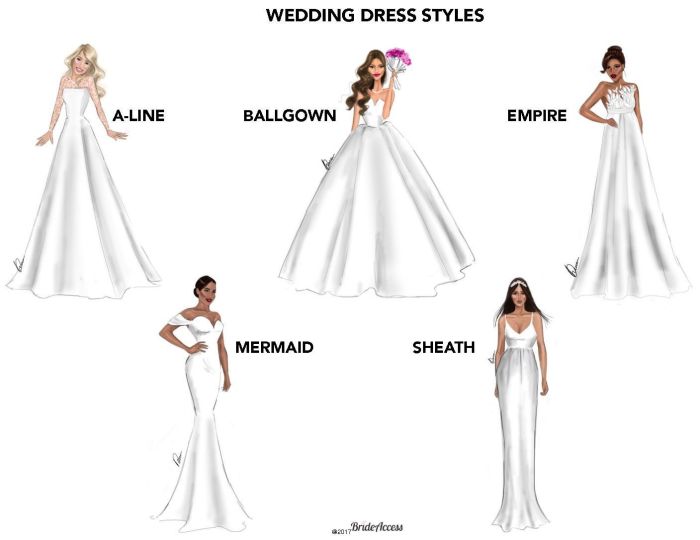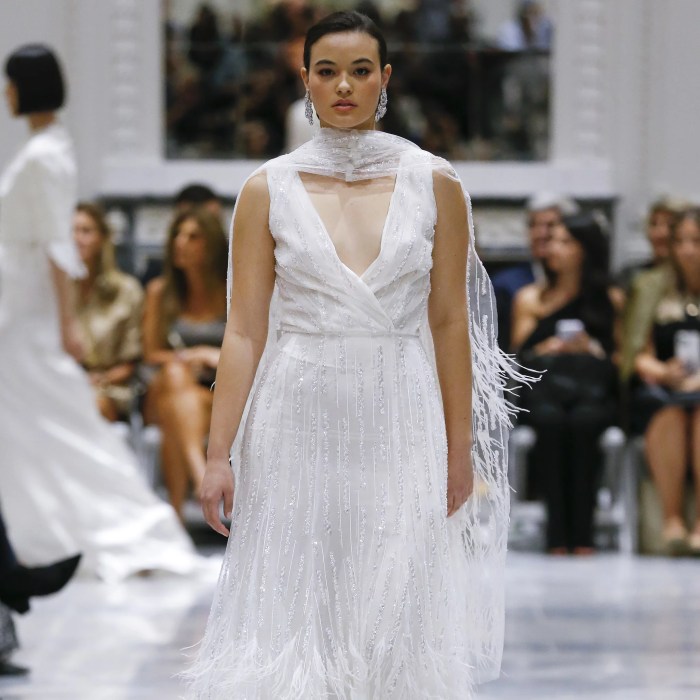Fashionable Wedding Dresses: A Guide to Finding Your Perfect Look

Source: boho-weddings.com
Fashionable dresses for wedding – Choosing a wedding dress is a significant decision, a blend of personal style and the momentous occasion. This guide explores the diverse world of fashionable wedding dresses, helping you navigate the options and find the perfect attire for your special day. We’ll delve into dress silhouettes, fabrics, colors, accessories, and the process of finding your dream dress.
Wedding Dress Silhouettes
The silhouette significantly impacts the overall look and feel of a wedding dress. Understanding the different options helps in choosing a style that flatters your body type and complements your personal style. Popular silhouettes include A-line, mermaid, ballgown, and sheath.
- A-line: This classic silhouette is flattering on most body types, featuring a fitted bodice that gradually flares out from the waist, creating an “A” shape. It offers comfort and movement.
- Mermaid: This dramatic silhouette hugs the body closely from the shoulders to the knees, then flares out into a dramatic train. It’s ideal for brides who want to showcase their curves and make a statement.
- Ballgown: A timeless choice, the ballgown features a fitted bodice and a full, voluminous skirt. It’s perfect for creating a fairytale look and is often chosen for formal weddings.
- Sheath: This sleek and sophisticated silhouette follows the body’s natural curves without being too tight. It’s a modern and elegant option suitable for various body types and wedding styles.
Neckline Styles and Their Suitability, Fashionable dresses for wedding
The neckline plays a crucial role in determining the overall aesthetic of the dress and can significantly impact how the dress looks on different body types. Consider your personal preferences and body shape when choosing a neckline.
- Sweetheart: This romantic neckline creates a heart shape at the bust, flattering most body types, particularly those with a smaller bust.
- V-neck: A V-neck elongates the torso, making it ideal for brides with a shorter torso or a fuller bust. It creates a sophisticated and elegant look.
- Halter: This neckline ties at the back of the neck, accentuating the shoulders and collarbone. It is flattering for brides with broad shoulders and a defined collarbone.
- Off-the-shoulder: This style showcases the shoulders and upper arms, offering a romantic and elegant look. It’s a versatile choice for various body types.
Sleeve Options and Their Impact
Sleeves add another layer of style and sophistication to a wedding dress. The choice of sleeves can drastically alter the overall aesthetic and suit different seasons and personal preferences.
- Sleeveless: A classic and versatile option, sleeveless dresses are perfect for warmer weather and allow for greater freedom of movement.
- Short Sleeves: Short sleeves offer a touch of elegance and can be paired with various necklines and silhouettes.
- Long Sleeves: Long sleeves are ideal for cooler weather and can add a touch of sophistication and drama.
- Cap Sleeves: These short, delicate sleeves cover the shoulders, offering a touch of modesty and elegance.
Wedding Dress Silhouettes, Necklines, Sleeves, and Body Types
| Silhouette | Neckline | Sleeves | Suitable Body Type |
|---|---|---|---|
| A-line | Sweetheart | Sleeveless | Most body types |
| Mermaid | V-neck | Long sleeves | Hourglass, athletic |
| Ballgown | Off-the-shoulder | Short sleeves | Most body types |
| Sheath | Halter | Cap sleeves | Slim, athletic |
Wedding Dress Fabrics and Materials
The fabric choice significantly influences the drape, texture, and overall look of the wedding dress. Different fabrics are better suited for different seasons, styles, and budgets.
- Silk: Luxurious and flowing, silk is a classic choice for wedding dresses. It drapes beautifully and feels comfortable against the skin, but it can be expensive and require careful maintenance.
- Satin: Satin has a smooth, lustrous surface and a beautiful sheen. It’s a versatile fabric suitable for various styles and seasons, but it can be less forgiving on body imperfections.
- Lace: Lace adds a touch of romance and elegance. It’s often used for overlays or accents, creating intricate detailing. It can be delicate and require careful handling.
- Tulle: Tulle is a lightweight, sheer fabric that is often used for creating volume and fullness in skirts. It’s airy and romantic, perfect for creating a fairytale look.
- Chiffon: Chiffon is a lightweight, flowing fabric that drapes beautifully. It’s perfect for creating a bohemian or romantic look, but it can be delicate and prone to wrinkling.
Fabric Comparison
- Silk: Luxurious texture, graceful drape, suitable for classic and elegant themes. More expensive and requires dry cleaning.
- Satin: Smooth texture, sleek drape, suitable for modern and glamorous themes. Can be less breathable and show imperfections.
- Lace: Delicate texture, structured drape, suitable for romantic and vintage themes. Can be delicate and require special care.
- Tulle: Sheer texture, voluminous drape, suitable for romantic and fairytale themes. Can be easily damaged.
- Chiffon: Lightweight texture, flowing drape, suitable for bohemian and beach themes. Can wrinkle easily.
Wedding Dress Colors and Trends
While white remains a classic choice, modern brides are increasingly embracing a wider range of colors for their wedding dresses. These colors can reflect personal style and the overall wedding theme.
- Ivory: A timeless alternative to stark white, ivory offers a softer, warmer hue.
- Blush: A romantic and delicate shade, blush pink adds a touch of femininity and elegance.
- Champagne: A sophisticated and understated choice, champagne offers a subtle elegance.
- Pastel Colors: Light blues, lavenders, and mints add a whimsical and romantic touch.
Color Palettes for Different Wedding Themes
- Rustic: Creams, ivories, dusty rose, and sage green.
- Modern: Clean whites, silvers, and grays.
- Classic: Ivory, white, and champagne.
- Bohemian: Creams, blush pinks, and earthy tones.
Wedding Dress Accessories and Styling
Accessories can elevate a wedding dress and personalize the look. Carefully chosen accessories can enhance the overall aesthetic without overpowering the dress itself.
- Veils: Veils add a touch of tradition and romance, ranging from short and delicate to long and dramatic.
- Jewelry: Subtle jewelry complements the dress without distracting from the overall look.
- Belts: Belts can cinch the waist and add definition to the silhouette.
- Headpieces: Headpieces add a touch of glamour and can range from simple combs to elaborate tiaras.
A Visual Description of a Bride’s Look

Source: popsugar-assets.com
Imagine a bride in a classic A-line gown of ivory silk, adorned with delicate lace appliqués. The sweetheart neckline showcases her décolletage, and the sleeveless design allows her to show off her toned arms. A simple, cathedral-length veil flows elegantly behind her, and a delicate pearl necklace complements the understated elegance of the dress. Her hair is styled in a soft updo, showcasing her features, with a few loose strands framing her face.
Finding the perfect fashionable dress for a wedding can be a delightful challenge. The options are endless, from flowing summer maxis to sophisticated cocktail numbers. However, if the wedding is a winter affair, consider a rich jewel tone; for example, a stunning blue winter wedding guest dress would be both elegant and seasonally appropriate. Ultimately, the most fashionable wedding guest dress is one that makes you feel confident and beautiful.
The overall effect is one of timeless elegance and effortless beauty.
Finding the Perfect Wedding Dress

Source: cloudfront.net
Finding the perfect wedding dress involves careful consideration of personal style, body type, and the wedding venue and theme. Professional guidance can be invaluable in this process.
- Define your style and budget: Browse magazines, websites, and social media for inspiration, identifying styles that resonate with you. Set a realistic budget.
- Consider the venue and theme: The dress should complement the setting and overall style of the wedding.
- Schedule appointments at bridal shops: Try on different styles and silhouettes to determine what flatters your body type.
- Seek professional guidance: A stylist or consultant can provide expert advice and help you find the perfect dress.
- Say yes to the dress!: Once you’ve found the dress that makes you feel beautiful and confident, say yes and start planning the rest of your wedding!
FAQ: Fashionable Dresses For Wedding
How far in advance should I start looking for my wedding dress?
Ideally, begin your search 9-12 months before your wedding to allow ample time for alterations and potential delays.
What should I wear when trying on wedding dresses?
Wear nude-toned undergarments and comfortable shoes that resemble the height of your wedding shoes. Consider bringing a strapless bra or the bra you plan to wear on your wedding day.
How much should I budget for a wedding dress?
Wedding dress budgets vary greatly, depending on the designer, fabric, and embellishments. Set a realistic budget early in the process.
Can I alter a wedding dress I’ve purchased?
Yes, most wedding dresses can be altered to achieve a perfect fit. Experienced seamstresses can adjust length, seams, and other details.
What if I gain or lose weight before my wedding?
Schedule a final fitting a few weeks before your wedding to account for any weight fluctuations. Minor adjustments can usually be made then.